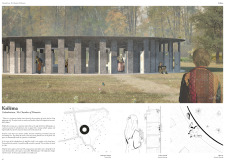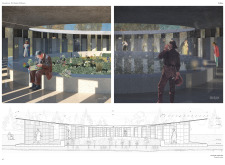5 key facts about this project
The Columbarium, also known as The Chamber of Memories, is situated at the edge of a forest. This structure is designed to facilitate personal reflection and memory. Its cylindrical form connects the built environment with nature, inviting visitors to explore their emotions and experiences in a quiet, contemplative space.
Architectural Concept
The concept behind the columbarium focuses on creating a retreat that coexists with the natural world. The building has an opaque cylindrical shape that serves as both a visual landmark and an invitation to explore within. Visitors can enter through various access points, emphasizing the theme of solitude in the context of collective remembrance. The relationship between the structure and its surroundings is essential to the overall experience.
Interior Organization
Inside, the columbarium features a series of niches that mirror the shapes found in the nearby trees. These niches are designed to hold funeral urns, and their small size enhances the personal nature of remembrance. This arrangement creates a calming rhythm that encourages introspection. A central area allows for movement and connection, offering space for contemplation and reflection among visitors.
Material Integration
Granite and steel are the main materials used in the columbarium’s construction. Granite is utilized for the niches and benches, providing a sense of permanence within the space. The roof, built with steel, gives stability while allowing for a light, thin canopy that shelters the interior. These choices in materials enhance the overall durability and create a visual link to the surrounding landscape.
Landscape Connection
The design emphasizes the relationship between the structure and the landscape. An access path leads visitors to the building, defining pathways and encouraging exploration. Benches are placed for reflection, and an impluvium serves to nurture plants, enhancing the outdoor experience. The impluvium is particularly important as it adapts to seasonal changes, deepening the connection between the memorial space and the environment.
The careful details come together in the impluvium, where rainwater is collected. This feature sustains the surrounding flora and serves as a reminder of the cycles of life and memory.






















































